



 At three a.m. a crew of bakers arrive to prepare from scratch all the bake goods and deli items for Burke's Bakery and Delicatessen in Dansville, Kentucky. Above one of the bakers is preparing crust for their cherry individual pies. In this room where she is working, it is ten o'clock in the morning, and much of the baking prep work has been completed. A large task as Burke's is a popular bakery and people start streaming in when the doors open at seven in the morn, six days a week -- on Sunday they open at noon.
At three a.m. a crew of bakers arrive to prepare from scratch all the bake goods and deli items for Burke's Bakery and Delicatessen in Dansville, Kentucky. Above one of the bakers is preparing crust for their cherry individual pies. In this room where she is working, it is ten o'clock in the morning, and much of the baking prep work has been completed. A large task as Burke's is a popular bakery and people start streaming in when the doors open at seven in the morn, six days a week -- on Sunday they open at noon. 

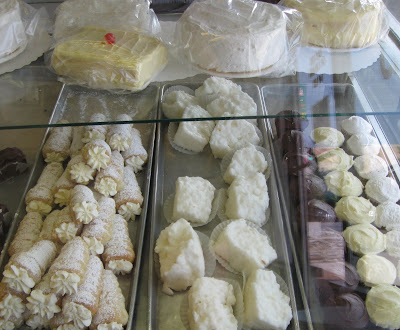

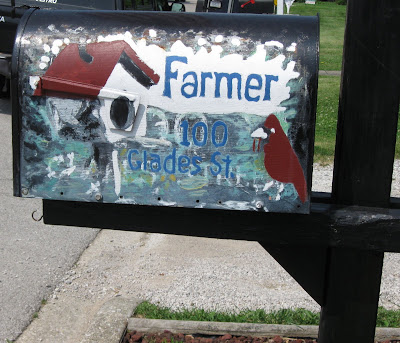
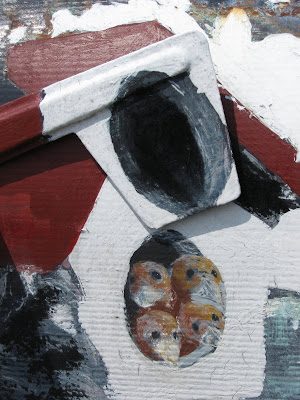 One, is that is was painted by a family member of the owner of the mailbox. And two, the painter is a well known artist in Kentucky by the name of David Farmer.
One, is that is was painted by a family member of the owner of the mailbox. And two, the painter is a well known artist in Kentucky by the name of David Farmer. I noticed this farm outbuilding several months ago and was stymied. I had many questions about it but the farm owners were not home and I was forty miles from where I lived so I snapped a few photos and went on my way. I have not been back to that area since.
I noticed this farm outbuilding several months ago and was stymied. I had many questions about it but the farm owners were not home and I was forty miles from where I lived so I snapped a few photos and went on my way. I have not been back to that area since. This particular outbuilding is located in the Possey area of Madison County, Kentucky.
This particular outbuilding is located in the Possey area of Madison County, Kentucky. Double set of entrance doors to Cox's Hardware store. In business since 1907. The small town of Mt Vernon's streetscape reflected in their door windows.
Double set of entrance doors to Cox's Hardware store. In business since 1907. The small town of Mt Vernon's streetscape reflected in their door windows.  Appears to be original entrance door on a vacated storefront business. Tile work entrance also appears to be original. Approximate building age -- 100 plus years.
Appears to be original entrance door on a vacated storefront business. Tile work entrance also appears to be original. Approximate building age -- 100 plus years. OVERVIEW OF THE VILLAGE OF PAINT LICK, KENTUCKY
OVERVIEW OF THE VILLAGE OF PAINT LICK, KENTUCKY
I was standing on a hill overlooking the quaint
This village consists of a very small commercial area (the proverbial main street) which serves the rural residents of the area. Of course, in today's economic world such small main streets can only provide limited offerings. Many of the small towns and villages in
The combination of access of an urban area and strong community spirit attract some new people while sustaining the existing residents. Residents learn to work with what they don't have in terms of services. Paint Lick doesn't have a gas station but it does have a car repair garage, bank, post office and until recently a cafe where the locals would converse about various subjects such as farming. Unfortunately the cafe recently burnt down.
In 1939 a book was published titled the WPA Guide to
Where am I going with this information? Well, I have a 1996 re-published edition of the 1939 edition of the WPA Kentucky Guide wrote and researched by the Federal Writers Project. I wanted to get their definition of
This is what I wanted to hear -- writers that looked at the soul of a place.
.
Although Paint Lick was limited to a very short mention they were able to write something significant that I had not been able to find elsewhere in my research -- that of the Indian symbols. Here is the short mention of Paint Lick: . . . a hamlet near the site of Paint Lick Station, which was established in 1782, and so named because the first settlers found Indian symbols painted in bright colors on trees and stones along the creek and around the near-by salt lick."
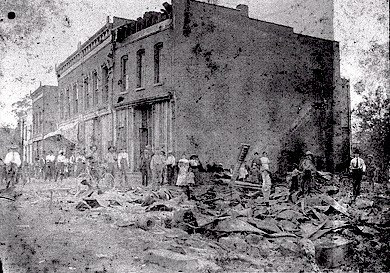 PAINT LICK MAIN COMMERCIAL STREET IN 1908 AFTER THEY SUFFERED A FIRE.
PAINT LICK MAIN COMMERCIAL STREET IN 1908 AFTER THEY SUFFERED A FIRE.
Paint Lick is a small town that manages to stay afloat because of its proximity to an urban area. It still has its small town flavor while growing incrementally. It has faced many challenges since its first days of settlement. One example is the tragic fire in the above main street photo. It has experienced population shifts mainly in the 40s through the 60s to the

EARLY YEARS OF PAINT LICK -- PRE--1908
Website Source: PAINT LICK, Garrard County, Kentucky
At one time Paint Lick consisted of mainly wooden buildings pre 1908. Its tenacity to the land provided the impetuous to remain a slowly growing village. In 1939 the population was 250 (WPA Guide to Kentucky), 2000 the population of Paint Lick was 2,084 (city-data.com) and in 2007 the population had increased to 3,293 (city-data.com).

DISTRIBUTION OF RESIDENTS AGES
Source: City-Data.com
One of the factors that is important to look at is the age of the residents. Age diversity indicates a viable population. The graph above shows that Paint Lick has citizens of all ages. Some for delight such as young children, many for working power such as the middle ages, and several in the older ages to hand-down proven ways and wisdom.
Paint Lick has the tools to survive as a rural village.
 SYNCHRONOUS FIREFLY FLASHING, DIFFICULT TO SEE, LOOK FOR TINY WHITE LIGHTS
SYNCHRONOUS FIREFLY FLASHING, DIFFICULT TO SEE, LOOK FOR TINY WHITE LIGHTS SAL, MR CURIOUS, SITS ON THE PORCH HELPING ME WATCH FOR FIREFLIES
SAL, MR CURIOUS, SITS ON THE PORCH HELPING ME WATCH FOR FIREFLIES THE SHIITAKE LOG GARDEN
THE SHIITAKE LOG GARDEN I was able to talk to Sean Clark, staff member of the Berea College Agricultural Department. He gave me a short albeit informative lesson in how they go about mushroom gardening.
I was able to talk to Sean Clark, staff member of the Berea College Agricultural Department. He gave me a short albeit informative lesson in how they go about mushroom gardening.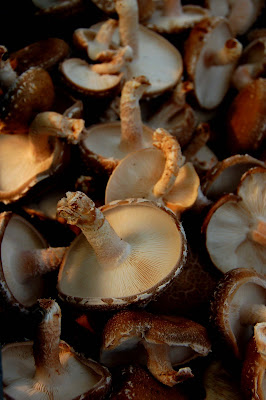 SHIITAKE MUSHROOMS TUMBLED IN A MASS REVEALING THEIR LIGHT UNDERSIDES
SHIITAKE MUSHROOMS TUMBLED IN A MASS REVEALING THEIR LIGHT UNDERSIDES